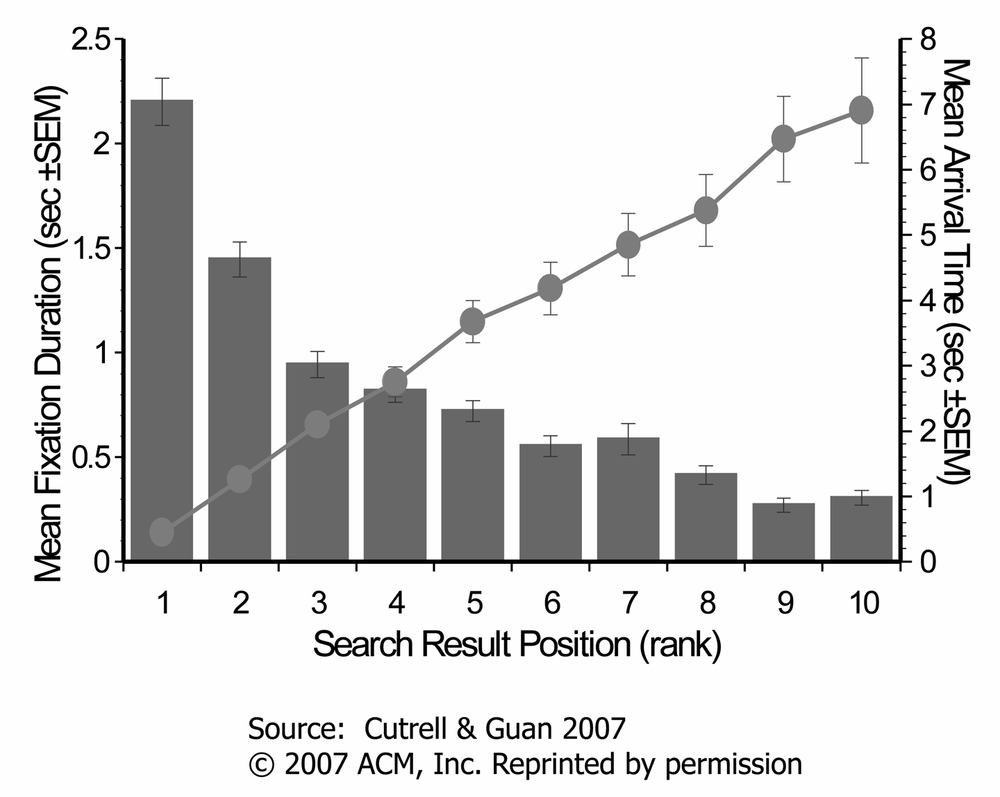Search engine marketing (SEM) is the process of using natural search engine optimization (SEO) and pay-per-click (PPC) advertising to increase the visibility of your website. To convert your newfound browsers into buyers and make the most of your advertising budget, SEM also includes conversion rate optimization (CRO). The chapters that follow will show you the best (and worst) practices for each of these topics, complete with case studies showing the techniques in action. First, let’s explore how people behave when using search engines.
To best optimize your website, it is important to understand how users interact with search engines. As you’ll discover, searchers are selective in their viewing of search engine result pages (SERPs) and spend little time on each page browsing results.
Good search result placement is important because most searchers (92.5%) don’t explore beyond the third page of search results. [1] In fact, about three-fourths don’t look past the first page of results. [2], [3] About 90% of searchers view only the first or second page of results. Yes, even on the Web the three most important elements of success are location, location, location.
Even within individual SERPs there are diminishing returns. During the initial search result view, higher SERP positions get measurably more attention, and consequently get more clicks than the lower positions (see Figure 1). [4]
Although lower-ranked results still get some notice (especially upon subsequent page views), the lion’s share of user attention and clicks are devoted to the first few results. This drop-off when attending to search results may be due to the perception of relevance for high-ranking results and information scent.
For search results, brevity is the soul of success. Short attention spans necessitate terse verse that is front-loaded, especially in PPC advertising. Confronted with an average of 25.5 links per query result, [5] e-commerce users view the average search result for only 1.1 seconds. [6] The average view for a natural result is 1.3 seconds, with only 0.8 seconds spent on a sponsored result at the top. Sponsored results on the right are viewed for only 0.2 seconds on average.
Clearly, people spend little time reading search results. These findings show the importance of crafting compelling, front-loaded title and description meta tags, and PPC headlines and summaries that are designed for quick scanning.
In the group of SEM chapters that follow, you’ll learn how to address these issues. In Chapter 1, you’ll learn best (and worst) practices to boost your rankings. Chapter 2 shows these SEO techniques in action. Chapters Chapter 3 and Chapter 4 do the same for PPC optimization, showing best-practice techniques to set up and optimize your PPC campaigns, with a case study showing how to execute these techniques within profit-driven goals. Chapter 5 shows how to optimize your landing pages with tight, persuasive copywriting and credibility-based design, and how to transform your website into a veritable lead-generating machine.
Finally, after Part II, Web Performance Optimization, Chapter 10 ties together the best metrics and tools that you can use to measure and optimize your SEM campaigns as well as your website performance to ensure your website’s success.
[1] Jansen, B., A. Spink, and S. Koshman. 2007. “Web Searcher Interaction with the Dogpile.com Metasearch Engine.” Journal of the American Society for Information Science and Technology 58 (5): 744–755.
[2] Ibid, 750. Found that 69.1% viewed the first SERP and 85.7% the second. Seventy-four percent is the average of 69.1% and Beitzel’s 79%; 89.8% who viewed up to the second SERP is the average of 85.7% and Beitzel’s 94%. Note that results are based on an analysis of Dogpile.com and AOL.com search logs.
[3] Beitzel, S. et al. 2006. “Temporal Analysis of a Very Large Topically Categorized Web Query Log.” Journal of the American Society for Information Science and Technology 58 (2): 166–178. Found that 79% viewed until the first SERP and 94% the second. Beitzel analyzed the query logfiles of AOL.com for this study.
[4] Cutrell, E., and Z. Guan. “What Are You Looking For? An Eye-Tracking Study of Information Usage in Web Search.” In CHI 2007 (San Jose, CA: April 28–May 3, 2007), 407–416; http://doi.acm.org/10.1145/1240624.1240690.
[5] Jansen, B. 2007. “The comparative effectiveness of sponsored and nonsponsored links for Web e-commerce queries.” ACM Transactions on the Web 1 (1): 25 pages. Analyzed search queries from Yahoo!, Google, and MSN.
[6] van Gisbergen, M.S. et al. 2006. “Visual attention to Online Search Engine Results.” Checkit, http://www.checkit.nl/pdf/eyetracking_research.pdf (accessed February 24, 2008). Eye-tracked Google, MSN, Ilse, Kobala, and Lycos.

